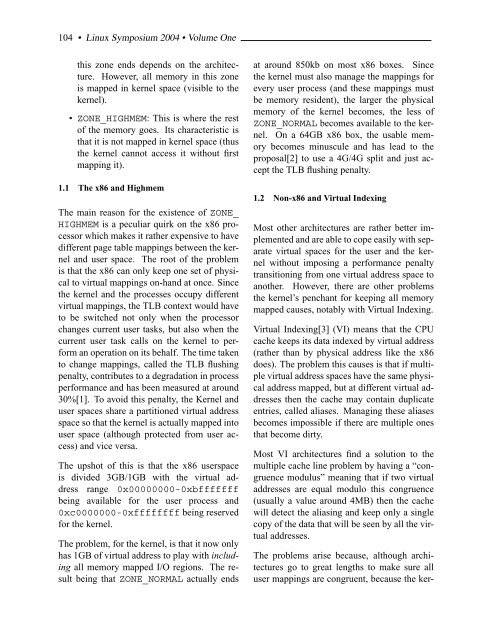You also want an ePaper? Increase the reach of your titles
YUMPU automatically turns print PDFs into web optimized ePapers that Google loves.
104 • <strong>Linux</strong> Symposium 2004 • Volume <strong>One</strong><br />
this zone ends depends on the architecture.<br />
However, all memory in this zone<br />
is mapped in kernel space (visible to the<br />
kernel).<br />
• ZONE_HIGHMEM: This is where the rest<br />
of the memory goes. Its characteristic is<br />
that it is not mapped in kernel space (thus<br />
the kernel cannot access it without first<br />
mapping it).<br />
1.1 <strong>The</strong> x86 and Highmem<br />
<strong>The</strong> main reason for the existence of ZONE_<br />
HIGHMEM is a peculiar quirk on the x86 processor<br />
which makes it rather expensive to have<br />
different page table mappings between the kernel<br />
and user space. <strong>The</strong> root of the problem<br />
is that the x86 can only keep one set of physical<br />
to virtual mappings on-hand at once. Since<br />
the kernel and the processes occupy different<br />
virtual mappings, the TLB context would have<br />
to be switched not only when the processor<br />
changes current user tasks, but also when the<br />
current user task calls on the kernel to perform<br />
an operation on its behalf. <strong>The</strong> time taken<br />
to change mappings, called the TLB flushing<br />
penalty, contributes to a degradation in process<br />
performance and has been measured at around<br />
30%[1]. To avoid this penalty, the <strong>Kernel</strong> and<br />
user spaces share a partitioned virtual address<br />
space so that the kernel is actually mapped into<br />
user space (although protected from user access)<br />
and vice versa.<br />
<strong>The</strong> upshot of this is that the x86 userspace<br />
is divided 3GB/1GB with the virtual address<br />
range 0x00000000-0xbfffffff<br />
being available for the user process and<br />
0xc0000000-0xffffffff being reserved<br />
for the kernel.<br />
<strong>The</strong> problem, for the kernel, is that it now only<br />
has 1GB of virtual address to play with including<br />
all memory mapped I/O regions. <strong>The</strong> result<br />
being that ZONE_NORMAL actually ends<br />
at around 850kb on most x86 boxes. Since<br />
the kernel must also manage the mappings for<br />
every user process (and these mappings must<br />
be memory resident), the larger the physical<br />
memory of the kernel becomes, the less of<br />
ZONE_NORMAL becomes available to the kernel.<br />
On a 64GB x86 box, the usable memory<br />
becomes minuscule and has lead to the<br />
proposal[2] to use a 4G/4G split and just accept<br />
the TLB flushing penalty.<br />
1.2 Non-x86 and Virtual Indexing<br />
Most other architectures are rather better implemented<br />
and are able to cope easily with separate<br />
virtual spaces for the user and the kernel<br />
without imposing a performance penalty<br />
transitioning from one virtual address space to<br />
another. However, there are other problems<br />
the kernel’s penchant for keeping all memory<br />
mapped causes, notably with Virtual Indexing.<br />
Virtual Indexing[3] (VI) means that the CPU<br />
cache keeps its data indexed by virtual address<br />
(rather than by physical address like the x86<br />
does). <strong>The</strong> problem this causes is that if multiple<br />
virtual address spaces have the same physical<br />
address mapped, but at different virtual addresses<br />
then the cache may contain duplicate<br />
entries, called aliases. Managing these aliases<br />
becomes impossible if there are multiple ones<br />
that become dirty.<br />
Most VI architectures find a solution to the<br />
multiple cache line problem by having a “congruence<br />
modulus” meaning that if two virtual<br />
addresses are equal modulo this congruence<br />
(usually a value around 4MB) then the cache<br />
will detect the aliasing and keep only a single<br />
copy of the data that will be seen by all the virtual<br />
addresses.<br />
<strong>The</strong> problems arise because, although architectures<br />
go to great lengths to make sure all<br />
user mappings are congruent, because the ker-

















